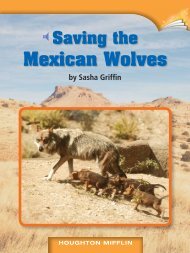Lesson 13:Louise Arner Boyd and Glaciers
Lesson 13:Louise Arner Boyd and Glaciers
Lesson 13:Louise Arner Boyd and Glaciers
You also want an ePaper? Increase the reach of your titles
YUMPU automatically turns print PDFs into web optimized ePapers that Google loves.
Chapter 4<br />
<strong>Glaciers</strong><br />
Newspaper reporters called <strong>Louise</strong> <strong>Boyd</strong> the “Ice Woman.”<br />
One of <strong>Boyd</strong>’s greatest accomplishments was sharing her<br />
knowledge of glaciers with the world. She helped others<br />
underst<strong>and</strong> how glaciers are formed <strong>and</strong> how they move.<br />
<strong>Glaciers</strong> are very important to the planet. They cover about<br />
10 percent of all the l<strong>and</strong> on Earth. As much as 75 percent of all<br />
fresh water on Earth is contained in glaciers. <strong>Glaciers</strong> are found<br />
all over the world, although most glaciers exist in polar areas in<br />
the Arctic <strong>and</strong> Antarctica.<br />
How <strong>Glaciers</strong> Form<br />
<strong>Glaciers</strong> require a certain climate to grow. They are found<br />
in areas that receive lots of snow in the winter <strong>and</strong> remain cool<br />
in summer. For a glacier to develop, it needs to be in a place<br />
where the amount of snow received every winter is greater<br />
than the amount of snow that melts in the summer. This type<br />
of climate exists mostly in high mountain areas <strong>and</strong> near the<br />
North <strong>and</strong> South poles.<br />
<strong>Glaciers</strong> form when snow builds up over time. Snow that<br />
lasts more than one year is called firn. Firn turns into ice when<br />
new snow presses on top of it. This densely compressed ice<br />
often takes on a bluish appearance.<br />
<strong>13</strong>

















